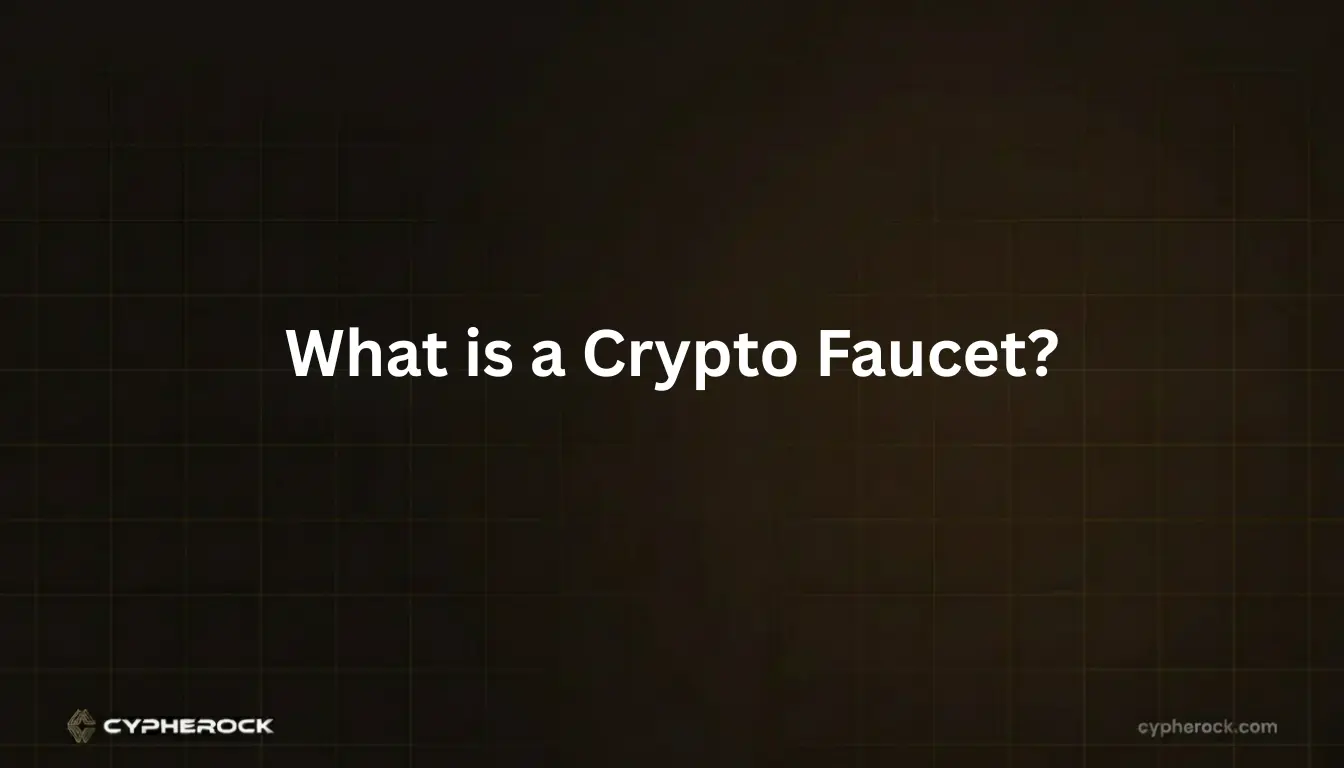

If you’ve typed “what does faucet mean” into a search bar, you’ve already taken the first step toward understanding a friendly on-ramp to cryptocurrency. At its simplest, faucet crypto hands out tiny amounts of cryptocurrency in exchange for small tasks, think captchas, short videos, or tiny micro-tasks. Those slow drips of value gave many people their first crypto experience, and by 2025 faucet crypto still plays a role in education, onboarding and developer testing.
This long-form guide explains everything: what a crypto faucet is, where faucet crypto came from (spoiler: the original Bitcoin Satoshi Faucet), how modern faucets work, the main types you’ll see in 2025, the best crypto faucets worth trying, plus the real benefits and risks. We’ll finish with practical safety steps and a step-by-step checklist so you can claim faucet crypto responsibly and move those tiny coins into secure custody when ready.
A crypto faucet is a website, app, or service that dispenses small, free amounts of cryptocurrency to users. The concept is simple: perform a light action (solve a captcha, view an ad, complete a quick task), and the faucet pays out a tiny portion of a coin. The metaphor is obvious, like water drips from a faucet, these services drip out satoshis or fractions of tokens over time. That’s why most people searching “what does faucet mean” in crypto quickly understand the analogy.
The origin story starts with the Bitcoin Satoshi Faucet, launched by Gavin Andresen in 2010. At a time when Bitcoin had almost no mainstream awareness, Andresen gave away 5 BTC per claim to encourage people to try sending and receiving coins. That early faucet was monumental, it introduced people to crypto wallets and transactions in a risk-free way. Over time the amounts dropped drastically (and naturally, 5 BTC in 2010 was trivial compared to today’s value), but the idea stuck: faucet crypto is an effective, low-friction educational tool.
Faucet crypto persisted because it addresses three needs at once:
By 2025, faucet crypto remains a legitimate way to gain tiny amounts of real tokens, interact with testnets, or gather micro-rewards. But the ecosystem matured: new faucet models, micro-wallets, aggregators, and safety practices now define responsible faucet use.
Understanding how faucet crypto works helps you use faucets safely and effectively. Below is a practical, step-by-step flow that reflects modern faucets in 2025.
Most faucets require some form of identification: either a simple account (email + password) or a wallet connection (MetaMask, Phantom, WalletConnect). For privacy and safety, many experienced users prefer claiming via a burner address or micro-wallet rather than their primary holdings.
Tasks vary by faucet:
Smaller faucets often credit a user account or a micro-wallet (like FaucetPay or similar services). These micro-wallets aggregate tiny payouts across multiple faucets until the balance reaches a withdrawal threshold. Aggregation reduces chain fees for tiny payouts, without this pooling, most micro-rewards would be wasted on network fees.
Each faucet or aggregator sets a minimum payout. Once you reach that threshold, you can request a transfer to your external wallet. For example, a faucet might require 10,000 satoshis or a small fraction of ETH before releasing funds on-chain.
After withdrawal, the coins land in your chosen wallet. Smart users move faucet crypto from micro-wallets to a burner wallet and then consolidate or send to secure storage (especially if the value grows). Always pay attention to network fees, sometimes it costs more to move tiny amounts than the rewards themselves.
Some users compound faucet earnings by investing small amounts into staking services or micro-DEX swaps (carefully, and only if fees are manageable). For many, the main value of faucet crypto is learning, not profit.
This basic flow shows why faucet crypto is an accessible introduction to the mechanics of wallets, transfers, and blockchain economics.
Not all faucets are the same. In 2025, faucet crypto falls into several practical categories: Bitcoin faucets (Satoshi faucets), Ethereum & testnet faucets, and multi-coin or auto faucets. Each type serves a distinct audience and purpose.
Bitcoin faucets focus on distributing satoshis, the smallest unit of BTC. These are the classic faucets inspired by the Bitcoin Satoshi Faucet. They pay out in satoshis either directly to a wallet or into a micro-wallet. Common tasks are captchas, lotteries, hourly roll games, and simple engagement tasks.
Pros: Wide awareness, BTC liquidity, established platforms.
Cons: Very small payouts per claim; fees and minimums can delay withdrawals.
Examples of Bitcoin-focused faucets that persisted or evolved include longstanding sites (some with loyalty programs). If you search for the best crypto faucets for Bitcoin, you’ll often find long-running options with consistent but small payouts.
Ethereum faucets come in two flavors: those that pay real ETH (rare and usually tied to promotions) and testnet faucets that dispense testnet ETH for development. For developers, faucets are indispensable for testing smart contracts, simulating complex DeFi flows, and experimenting with token transfers.
Testnet faucet use cases:
These faucets are often rate-limited and require a GitHub account or social proof to prevent abuse.
Multi-coin faucets let users claim from many tokens in a single interface. Platforms like FireFaucet and aggregator services provide auto-claim options, point systems, and conversion features. They’re often the best crypto faucets for users who want variety and automation.
Pros: Convenience, variety, cross-claims.
Cons: Ads, data collection, and sometimes lower per-coin payouts.
Understanding which faucet type suits you will shape your safety posture and expected returns. For beginners, trying a Bitcoin faucet and a testnet faucet side-by-side offers both real-token experience and developer practice.
When evaluating the best crypto faucets in 2025, look for reputation, payout reliability, user experience, and withdrawal transparency. Below are several notable faucet categories and representative examples.
These examples illustrate the different flavors of faucet crypto. The “best” faucet depends on your goals: learning, collecting satoshis, or testing smart contracts. Always check current reviews and community feedback, faucet reliability changes over time.
Many users ask: why use faucet crypto at all? The benefits are practical and often educational.
Faucets let you experience wallets, transactions, and network fees without risking capital. They’re ideal for first-time users to learn basic flows.
Although small, consistent claims plus referrals and loyalty bonuses can add up. For beginners, accumulating satoshis is a tangible reward for time spent learning.
Testnet faucets supply test tokens that enable building and debugging. Without these faucets, the development lifecycle for dApps would be significantly harder.
Projects distribute tokens to widen awareness or bootstrap community engagement. A token claim can introduce you to a new ecosystem.
Some faucets are educational: complete a mini-course and earn a token. This gamified learning can accelerate comprehension of blockchain fundamentals.
So when you ask “what does faucet mean” in terms of value, the answer is: it’s an inexpensive way to get practical experience and tiny rewards that help demystify crypto.
While faucet crypto can be useful, safety must come first. Faucets are attractive targets for scammers and ad networks that distribute malware. Here are robust safety rules and mitigation techniques.
If privacy matters, avoid reusing addresses across faucets and services. Dusting attacks can try to tie multiple addresses together. Use fresh addresses and consolidate via privacy-preserving techniques only if you understand their implications.
By following these practices, you can enjoy faucet crypto without exposing your main holdings to unnecessary risk.
The big question: how profitable is faucet crypto? Realistically, faucet crypto is not a route to wealth. Here’s what you can expect in 2025.
If a faucet pays 100 satoshis per day and you claim every day for a year, that’s 36,500 satoshis (~0.000365 BTC). In dollar terms, that is modest and sensitive to BTC price changes. Rarely will faucet crypto replace earned income, but it can provide small, cumulative value plus learning.
Treat faucet crypto as educational and supplemental. If you convert faucet crypto into meaningful holdings, transfer to secure custody and consider compounding strategies only when network fees make sense.
Here’s a compact, safe checklist so you can start claiming faucet crypto effectively.
Below are the frequent questions beginners ask about faucet crypto, with concise, practical answers.
Q1 — What does faucet mean in crypto?
A: “Faucet” means a service that drips small amounts of crypto to users for completing simple tasks — comparable to drops from a water tap.
Q2 — Are crypto faucets safe?
A: Some are safe; many are not. Use burner wallets, avoid approving unknown contracts, and move earnings to secure cold wallets when significant.
Q3 — How long until I can withdraw from a faucet?
A: Withdrawal timing depends on the platform. Some faucets allow quick withdrawals; many require a minimum balance to cover network fees.
Q4 — Is the original Bitcoin Satoshi Faucet still active?
A: Gavin Andresen’s original faucet is no longer active in its original form. It inspired many successors and the modern concept of faucet crypto distribution.
Q5 — Which are the best crypto faucets?
A: “Best” depends on needs: FreeBitco.in and Cointiply (BTC-focused), FireFaucet (multi-coin auto faucet), and QuickNode’s faucet (testnet ETH) are commonly referenced. Always verify current reputation and user feedback.
These answers should help you get started on safe, sensible faucet crypto activity.
Faucet crypto remains a unique tool in the crypto ecosystem, a low-barrier way to experience blockchains, an easy on-ramp for curious newcomers, and an essential resource for developers on testnets. By 2025, faucet models evolved but kept the same core promise: tiny, accessible tokens for tiny tasks.
Keep a few rules in mind: use burner wallets for claims, avoid approving unknown contracts, aggregate with micro-wallets carefully, and move valuable earnings into secure custody. If you’re ready to take those tiny gains seriously, protect your crypto with robust cold storage.If you plan to move your faucet earnings off exchanges, secure them in trusted cold storage Cypherock X1 is one of the best cold wallets in the crypto industry.
